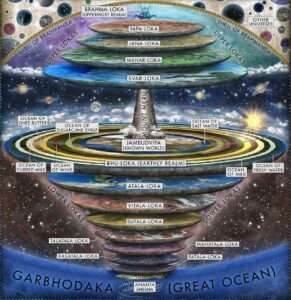The flat earth theory and the multidimensionality of creation
Cosmography (Nakshatra Vidya or Jyotisha), namely the description of our universe, is one of the sciences that are dealt with by all the Puranas. Actually, a Purana is not accepted as such without a description of our universe. It’s a long and complicated topic. On this we may write books and books, and actually, important scholars have done that.
So in the few paragraphs I want to dedicate now to this topic, I’ll just say something.
First of all, the planet (Earth) that we perceive is spherical. It’s not flat. Guru says so, Sastra says so and our senses and intelligence say so.
However, there could be a twist on this truth, and I’ll try to explain it.
The paper I published some time ago suggested that the creation is based on multidimensionality. In other words, depending on our elevation, we see things that others can’t see.
In the Sastra we find descriptions of a universe that for us simply doesn’t exist. We can’t see it. We experience something different.
Just one amongst many examples, is the famous Fifth Canto of the Srimad-Bhagavatam. We don’t see Bhumandala, nor Jambudvipa, nor the Ganges coming down, not the Sisumara planetary systems; neither will we ever be able to prove that the diameter of our universe is only 4 billion miles. And we can go on and on.
One thing is certain: Sukadeva Gosvami was seeing something that only he and advanced yogis or souls like him could see. He was describing a different dimension of our same universe.
Ruling out that the puranic descriptions are fantasies, and ruling out that Sastras make mistakes, the only acceptable explanation is that the universe is multidimensional. We see what our senses allow us to see.
The evidences of this fact are innumerable.
In Srimad-Bhagavatam Narada Muni glorifies the intelligence of his father, Sri Brahmaji, saying that his creation was so difficult to understand that even he couldn’t understand how it is made. Now, it is a fact that it is not easy to understand the description we study in the Puranas, but it is also not so complicated as to make difficulties in understanding Narada Muni. Using a simple software like Excel, one can easily arrive to calculate the distances between the Sun and Satyaloka and the distances between the Sun and the bottom of Garbhodaka Ocean. Even we, who have a fraction of Narada’s intelligence, can understand some of it.
So why did Narada Muni seem so impressed?
We find in the Bhagavad-gita there is an illuminating verse:
na tu mam sakyase drastum
anenaiva sva-caksusa
divyam dadami te caksuh
pasya me yogam aisvaram
“But you cannot see Me with your present eyes. Therefore I give you divine eyes. Behold My mystic opulence!”
Krishna is saying that Arjuna’s senses were not able to see something that was existing. He needed a more powerful set of senses.
Even Srila Prabhupada once gave a cryptic answer to one of his disciples that alerted my curiosity. The devotee asked him if the “earth is round and flat, both, together,” and our Acarya said, “yes”.
Therefore, it is clear to me (in my humble understanding) that the effort of trying to match the Srimad-Bhagavatam description of creation with what we see or can see with our senses is futile, because they are two different dimensions of existence.
In one dimension we see the Moon small and close, and in another we see the Moon farther and bigger. In one dimension we see only eight planets floating around space in our solar systems, and in another you see fourteen planetary systems with only one Sun to illuminate the whole universe and a number of planets that we can’t even perceive. In one dimension we see the Moon and Mars as two big, deserted rocks and in the other you see people and cities there.
This is a section of the book “On a Silver Platter”.
To buy the complete book, click here
Post view 78 times




Leave a Reply